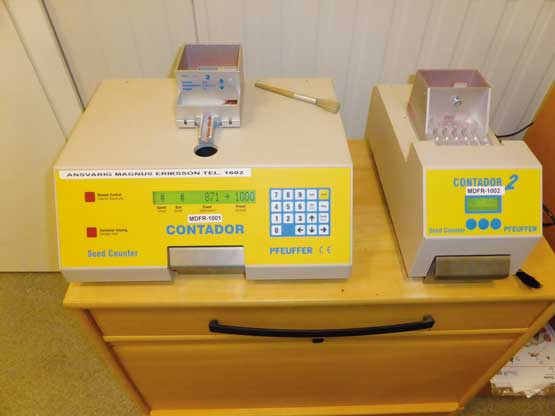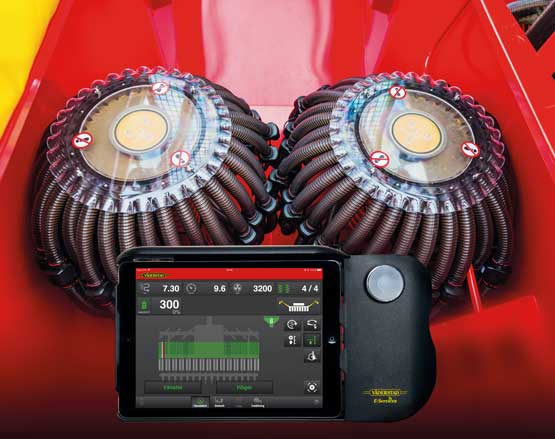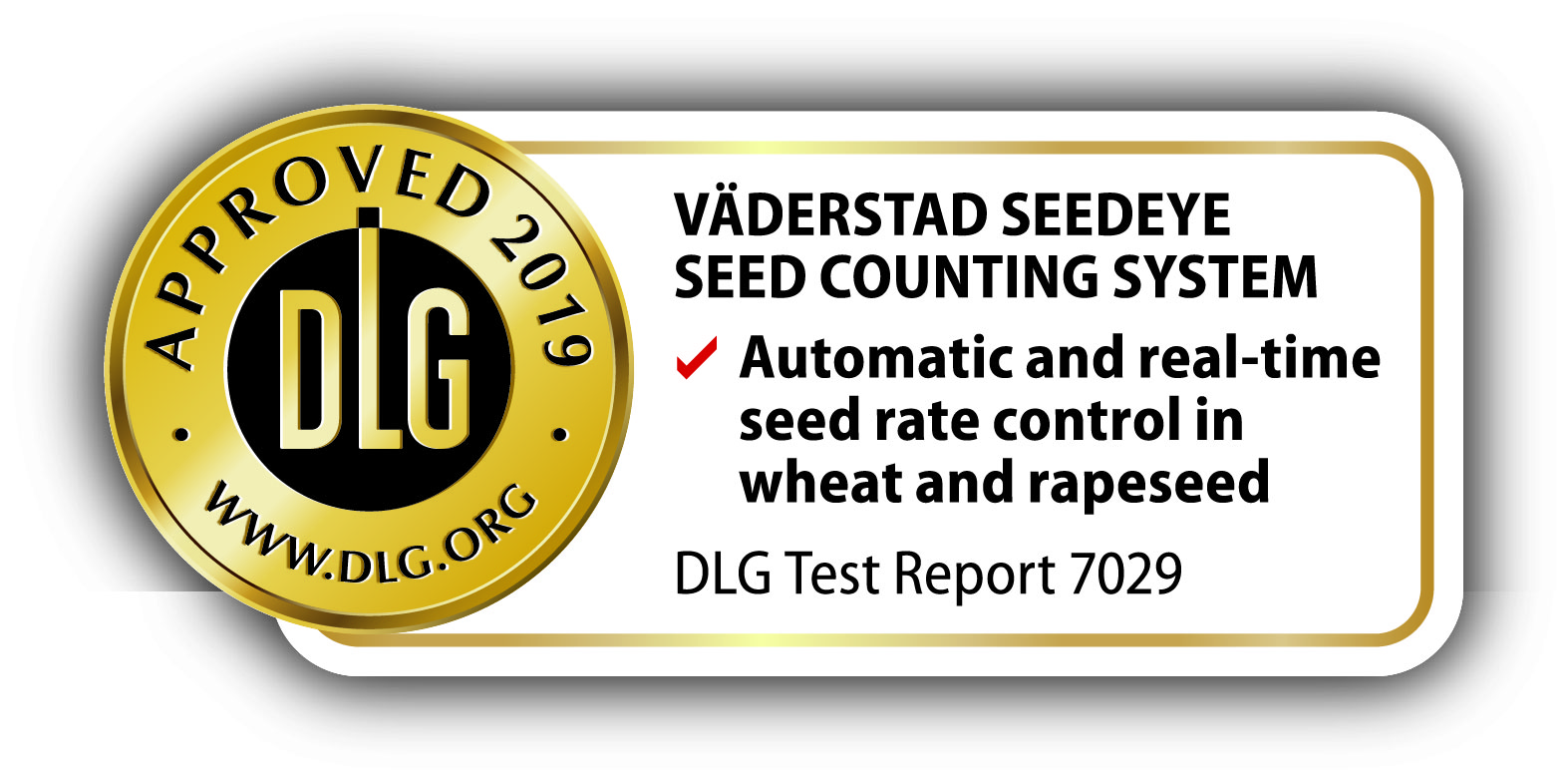VÄDERSTAD SeedEye seed counting system
Automatic and real-time seed rate control in wheat and rapeseed
The quality mark
A test mark „DLG-APPROVED for individual criteria“ is awarded for agricultural products which have successfully fulfilled a scope-reduced usability testing conducted by DLG according to independent and recognized evaluation criteria. The test is intended to highlight particular innovations and key criteria of the test object. The test may contain criteria from the DLG test scope for overall tests, or focus on other value-determining characteristics and properties of the test subject. The minimum requirements, test conditions and procedures as well as the evaluation bases of the test results will be specified in consultation with an expert group of DLG. They correspond to the recognized rules of technology, as well as scientific and agricultural knowledge and requirements. The successful testing is concluded with the publication of a test report, as well as the awarding of the test mark which is valid for five years from the date of awarding.
The Väderstad SeedEye seed counting system was subjected to a DLG test which tested the “Automatic and real-time seed rate control in wheat and rapeseed” on a pneumatic Väderstad Rapid A 600S. The test was carried out on a test stand (lab test) in 2019. The lab test measured and assessed the accuracy of seed counting in wheat and rapeseed. In addition, it tested the response of the SeedEye system to blockages in one seed coulter and in the distribution head as well as its response to a failure of several sensors. No other criteria were tested in this test.
Assessment – Brief Summary
The performance of the Väderstad SeedEye seed counting system was impressive in the test that was conducted by the criteria laid down in the DLG test framework. Based on the results obtained, the product is awarded the DLG-APPROVED test mark for its “Automatic and real-time seed rate control in wheat and rapeseed”.
Table 1: Lab test results (counting accuracy)
| Test criterion | Test result |
|
Counting accuracy in wheat (7.5 km/h ground speed, application, rate: 200 seeds/square metre) | Deviation of the actual rate from the target rate: very good |
|
Counting accuracy in wheat (15 km/h ground speed, application, rate: 200 seeds/square metre) | Deviation of the actual rate from target rate: good |
|
Counting accuracy in wheat (15 km/h ground speed, application, rate: 400 seeds/square metre) | Deviation of the actual rate from the target rate: very good |
|
Counting accuracy in rapeseed (7.5 km/h ground speed, application, rate: 30 seeds/square metre) | Deviation of the actual rate from the target rate: very good |
|
Counting accuracy in rapeseed (15 km/h ground speed, application, rate: 30 seeds/square metre) | Deviation of the actual rate from the target rate: very good |
|
Counting accuracy in rapeseed (15 km/h ground speed, application, rate: 60 seeds/square metre) | Deviation of the actual rate from the target rate: very good |
In a next step, it was examined how the system responded when ten percent of the sensors failed. In that case, the system continued applying the seeds at the pre-set rate, which means that the sensor failure had no major impact on the set seed rate.
In another scenario, the testers created blockages in one seed coulter and in one distribution head. Then they measured the time the system took to issue an alarm on the operator iPad. On average, it took about 3 seconds for the iPad to indicate that the coulter was blocked. Blockages inside the distribution head were indicated after 3.6 seconds.
The Product
Description and technical data
The Väderstad SeedEye is a seed counting system on a drill that adjusts the seed rate automatically to the entered settings. According to the manufacturer, the system is suitable for counting the following crops: wheat, rapeseed, barley, rye, peas, beans, hybrid barley, hybrid rye.
The operator enters the target rate to the Väderstad E-Control software application (by entering the number of seeds per square metre) (Figure 2).
After the operator selected the crop and entered the seed rate, the software prompts the recommended cell volume of the cell wheels on the two seed metering units. The volume is set manually by operating a crank handle. After that, the machine is ready to drill. The distribution heads have optical sensors that detect the seeds as they leave the heads. There is one sensor on each outlet of each head (Figure 3).
Each sensor has six internal optical diodes that detect the seeds. On the outside of each sensor there is an LED light bar which indicates its current status:
- Continuous green: Sensor is ready
- Green flashing: When drilling is in progress, one flash per detected seed
- Continuous red: Malfunction; blockage or contamination
- Continuous yellow: Initialising, registering, configuring
- Continuous blue: Updating software
The circumference speed of the two cell wheels is determined using the target rate and the actual rate as it is measured by the optical sensors. Then the speed is set hydraulically. The seed rate is monitored continuously and automatically adjusted to target if necessary. SeedEye is able to count regular seeds, which means it is not necessary to use standardised seeds.
In the DLG test, SeedEye was installed to a Väderstad Rapid A 600S pneumatic seed drill. The drill has 48 single-disc coulters which cover a working width of 6 metres (at 12.5 cm coulter spacing). The two distribution heads in the seed hopper are supplied with seeds by the two variable-volume cell wheels. The ground speed, which is necessary to meter the rate, is measured by a radar speed sensor that is installed on the drill. It is also possible to use the speed signal of the tractor.
The Method

determine the number of seeds that were drilled out over a specific period of time.
The DLG test “Automatic and real-time seed rate control in wheat and rape seed” is carried out at the lab.
The test system is mounted on a drill. This drill is powered by a stationary tractor. The counting accuracy is measured using dressed wheat and rape seeds.
Over a specific period of time, these seeds are collected as they leave the coulters while the theoretically covered area [m²] is determined. Then the seeds collected in trays are counted by means of a seed counter (Figure 4). The actual seed rate is computed [seeds/m²] based on seed count and area covered and this rate is compared with the target rate that was entered to the system. Any deviations are assessed to the DLG scheme. See table 2.
The following target rates were selected for wheat and rapeseed:
- 200 seeds/m² of dressed wheat applied at a ground speed of 7,5 km/h
- 200 seeds/m² of dressed wheat applied at a ground speed of 15 km/h
- 400 seeds/m² of dressed wheat applied at a ground speed of 15 km/h
- 30 seeds/m² of dressed rape seed applied at a ground speed of 7,5 km/h
- 30 seeds/m² of dressed rape seed applied at a ground speed of 15 km/h
- 60 seeds/m² of dressed rape seed applied at a ground speed of 15 km/h
In an additional test scenario, the actual seed rate was measured after ten percent of the optical sensors on one distribution head were disabled. In another scenario, blockages were applied to one coulter and the distribution head to simulate foreign objects clogging the system. Then, drilling was resumed and the time was measured that it took the system to issue an alarm to the operator.
Detailed account of the test results
The results of the lab test are discussed and assessed as follows:
Counting accuracy in wheat and rapeseed
The counting accuracy was measured while operating the system at two different ground speeds: 7.5 km/h and 15 km/h. The drill was powered by John Deere 6215 R during the lab test. The following seeds were drilled:
- Wheat variety Olivin, dressed (TGW: 44.44 g)
- Rape variety Explicit, dressed (TGW: 5.29 g)
The three test runs in wheat produced deviations from target of 2.5 percent, 3.5 percent and 1.8 percent. A deviation of 3.5 percent is considered “good” according to the DLG evaluation grid. The results of the other two tests are rated “very good” (Table 3).
The three test runs in rapeseed produced deviations from target of between 0 and 2 percent. These results are rated as “very good” to the DLG evaluation grid (Table 3).
Table 3: Väderstad SeedEye seed counting accuracy in wheat and rapeseed
|
Crop (dressed) |
Forward speed [km/h] |
Target rate [seeds/m²] |
Actual rate [seeds/m²] |
Deviation [%] |
Assessment of the deviation |
|---|---|---|---|---|---|
| Wheat | 7.5 | 200 | 205.0 | 2.5 | very good |
| Wheat | 15.0 | 200 | 207.0 | 3.5 | good |
| Wheat | 15.0 | 400 | 407.0 | 1.8 | very good |
| Rape | 7.5 | 30 | 29.4 | 2.0 | very good |
| Rape | 15.0 | 30 | 30.0 | very good | |
| Rape | 15.0 | 60 | 60.0 | very good |
Seed counting accuracy at sensor failure
In another seed counting test scenario, ten percent of the sensors were intentionally disabled. As the test run was in progress, the testers set the target rate to 60 rape seeds per square metre at a forward speed of 15 km/h. The actual seed rate measured during the test was 59 rape seeds per square metre, which reflects a deviation of 1.7 percent (from target).
This means the set seed rate did not change significantly after ten percent of the optical sensors on one distribution head were disabled.
Blockage alarms
When blockages were applied to one seed coulter in three instances (drilling wheat at 300 seeds per square metre at 11 km/h), the system took 3 seconds, 3.1 seconds and 3.6 seconds to issue an alarm on the operator’s iPad (3.2 seconds on average).
When blockages were applied to one seed coulter in three instances (drilling rapeseed at 45 seeds per square metre at 11 km/h), the system took 3.5 seconds, 2.3 seconds and 2.7 seconds to issue an alarm on the operator’s iPad (2.8 seconds on average).
The blockages on the distribution head were indicated to the operator after 3.5 seconds, 3.5 seconds and 3.9 seconds during the DLG test (3.6 seconds on average). The prompt that shows the malfunction also shows the seed tube number plus the control bar on the main screen turns red.
Summary
The Väderstad SeedEye seed counting system scored predominantly ‘very good’ results in the lab test (counting accuracy). When ten percent of the optical sensors on the distribution head were disabled, the seed rate did not change significantly.
Blockages on the seed coulter were indicated on the iPad after an average of 3 seconds. Blockages inside the distribution head were indicated after 3.6 seconds. The system also indicates the number of the affected seed tube. Based on these results that were obtained in a partial test in 2019, the Väderstad SeedEye seed counting system is awarded the DLG-APPROVED quality mark in the partial test category “Automatic and real-time seed rate control in wheat and rape seed”.
Manufacturer and applicant
Manufacturer and applicant
Applicant:
Väderstad GmbH
Am Berliner Ring 8, 14542 Werder (Havel)
Phone +49 33207 308715,
infoDE@vaderstad.com
Manufacturer:
Väderstad AB
Hogstadvägen 2, 590 21 Väderstad, Sweden
Phone. +46 142 820-00
Test performed by
Testing agency
DLG TestService GmbH,
Gross-Umstadt location, Germany
The tests are conducted on behalf of DLG e.V.
DLG test framework
Drills (as per 2019)
Department
Agriculture
Head of Department
Dr. Ulrich Rubenschuh
Test engineer(s)
Dipl.-Ing. agr. Georg Horst Schuchmann *
* Author
Contact
DLG TestService GmbH - Groß-Umstadt location • Max-Eyth-Weg 1 64823 Groß-Umstadt Germany • Tel.: +49(0)69 24 788-611 • tech@DLG.org




